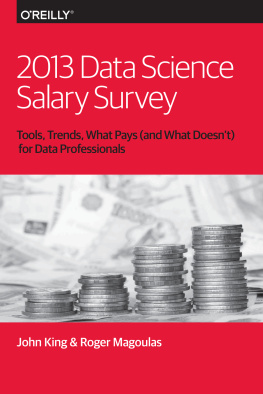Brian Suda&King John - 2017 European data science salary survey
Here you can read online Brian Suda&King John - 2017 European data science salary survey full text of the book (entire story) in english for free. Download pdf and epub, get meaning, cover and reviews about this ebook. City: Europe., Sebastopol, CA, year: 2017, publisher: OReilly Media, Inc., genre: Home and family. Description of the work, (preface) as well as reviews are available. Best literature library LitArk.com created for fans of good reading and offers a wide selection of genres:
Romance novel
Science fiction
Adventure
Detective
Science
History
Home and family
Prose
Art
Politics
Computer
Non-fiction
Religion
Business
Children
Humor
Choose a favorite category and find really read worthwhile books. Enjoy immersion in the world of imagination, feel the emotions of the characters or learn something new for yourself, make an fascinating discovery.
- Book:2017 European data science salary survey
- Author:
- Publisher:OReilly Media, Inc.
- Genre:
- Year:2017
- City:Europe., Sebastopol, CA
- Rating:3 / 5
- Favourites:Add to favourites
- Your mark:
2017 European data science salary survey: summary, description and annotation
We offer to read an annotation, description, summary or preface (depends on what the author of the book "2017 European data science salary survey" wrote himself). If you haven't found the necessary information about the book — write in the comments, we will try to find it.
Get a clear picture of the salaries and bonuses data science professionals around the world receive, as well as the tools and cloud providers they use, the tasks they perform, and how interpersonal (soft) skills might affect their pay. The fifth edition of OReillys online Data Science Salary Survey provides complete results from nearly 800 participants from 69 different countries, 42 different US states, and Washington, DC.
With five years of data, the surveys results are consistent enough to reliably identify changes and trends. The survey asked specific questions about industry, team, and company size, but also posed questions such as, How easy is it to move to another position? or What is your next career step? You can plug in your own data points to the survey model and see how you compare to other data science professionals in your industry.
With this report, youll learn:
- Where data scientists make the highest salariesby country and by US state
- Tools that respondents most commonly use on the job, and tools that contribute most to salary
- Activities that contribute to higher earnings
- How gender and bargaining skills affect salaries when all other factors are equal
- Salary differences between those using open source tools vs those using proprietary tools
- How the increase in respondents outside of the US signal a rise in international companies starting and growing data organizations
Participate in the 2018 Survey: Spend just 5 to 10 minutes and take the anonymous salary survey here: https://www.oreilly.com/ideas/take-the-data-science-salary-survey.
Brian Suda&King John: author's other books
Who wrote 2017 European data science salary survey? Find out the surname, the name of the author of the book and a list of all author's works by series.

















